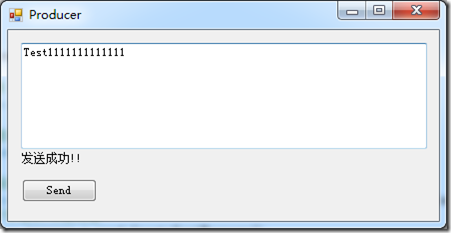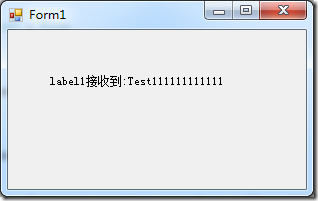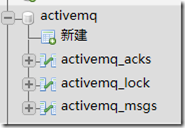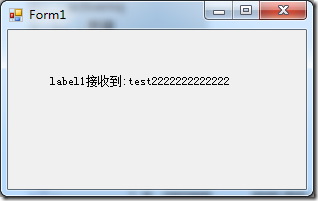C#使用ActiveMQ实例
1. ActiveMQ消息总线简介
消息队列(Message Queue,简称MQ),从字面意思上看,本质是个队列,FIFO先入先出,只不过队列中存放的内容是message而已。主要用作不同进程、应用间的通信方式。
常见的消息队列有:rabbitMQ、activeMQ、zeroMQ、Kafka、Redis 比较 。
其中ActiveMQ是Apache出品的一款开源消息总线,支持多种语言和协议编写客户端。语言: Java,C,C++,C#,Ruby,Perl,Python,PHP。应用协议: OpenWire,Stomp REST,WS Notification,XMPP,AMQP。
ActiveMQ主要有两种消息分发方式:Queue和Topic。
Queue类似编程语言中的Queue,每条消息只会被一个消费者接收;
Topic类似广播,发送的消息会被多个消费者接受,前提是订阅了该主题的消息。
2. ActiveMQ安装
2.1. 下载ActiveMQ
官方网站下载地址:http://activemq.apache.org/
2.2. 运行ActiveMQ
解压缩apache-activemq-5.10.0-bin.zip,然后双击apache-activemq-5.10.0\bin\win32\activemq.bat运行ActiveMQ程序。
看见控制台最后一行输出: “access to all MBeans is allowed” 证明启动成功。
启动ActiveMQ以后,可以使用浏览器登陆:http://localhost:8161/admin/验证, 默认用户名是:admin 密码是:admin
(前提是安装好Java环境)
同时下载.net版Dll:Apache.NMS-1.7.0-bin.zip和Apache.NMS.ActiveMQ-1.7.0-bin.zip
都从这里下载:http://archive.apache.org/dist/activemq/apache-nms/1.7.0/
3. ActiveMQ Queue
在ActiveMQ中Queue是一种点对点的消息分发方式,生产者在队列中添加一条消息,然后消费者消费一条消息,这条消息保证送达并且只会被一个消费者接收。
这里使用Winform编写程序,其中需要添加两个dll,都在Apache.NMS-1.7.0-bin.zip和Apache.NMS.ActiveMQ-1.7.0-bin.zip中。
// 生产者 // 需要添加一个label, button, textbox public Form1() { InitializeComponent(); InitProducer(); } private IConnectionFactory factory; public void InitProducer() { try { //初始化工厂,这里默认的URL是不需要修改的 factory = new ConnectionFactory("tcp://localhost:61616"); } catch { lbMessage.Text = "初始化失败!!"; } } private void btnConfirm_Click(object sender, EventArgs e) { //通过工厂建立连接 using (IConnection connection = factory.CreateConnection()) { //通过连接创建Session会话 using (ISession session = connection.CreateSession()) { //通过会话创建生产者,方法里面new出来的是MQ中的Queue IMessageProducer prod = session.CreateProducer(new Apache.NMS.ActiveMQ.Commands.ActiveMQQueue("firstQueue")); //创建一个发送的消息对象 ITextMessage message = prod.CreateTextMessage(); //给这个对象赋实际的消息 message.Text = txtMessage.Text; //设置消息对象的属性,这个很重要哦,是Queue的过滤条件,也是P2P消息的唯一指定属性 message.Properties.SetString("filter","demo"); //生产者把消息发送出去,几个枚举参数MsgDeliveryMode是否长链,MsgPriority消息优先级别,发送最小单位,当然还有其他重载 prod.Send(message, MsgDeliveryMode.NonPersistent, MsgPriority.Normal, TimeSpan.MinValue); lbMessage.Text = "发送成功!!"; txtMessage.Text = ""; txtMessage.Focus(); } } }
// 消费者 public Form1() { InitializeComponent(); InitConsumer(); } public void InitConsumer() { //创建连接工厂 IConnectionFactory factory = new ConnectionFactory("tcp://localhost:61616"); //通过工厂构建连接 IConnection connection = factory.CreateConnection(); //这个是连接的客户端名称标识 connection.ClientId = "firstQueueListener"; //启动连接,监听的话要主动启动连接 connection.Start(); //通过连接创建一个会话 ISession session = connection.CreateSession(); //通过会话创建一个消费者,这里就是Queue这种会话类型的监听参数设置 IMessageConsumer consumer = session.CreateConsumer(new Apache.NMS.ActiveMQ.Commands.ActiveMQQueue("firstQueue"), "filter='demo'"); //注册监听事件 consumer.Listener += new MessageListener(consumer_Listener); //connection.Stop(); //connection.Close(); } void consumer_Listener(IMessage message) { ITextMessage msg = (ITextMessage)message; //异步调用下,否则无法回归主线程 tbReceiveMessage.Invoke(new DelegateRevMessage(RevMessage),msg); } public delegate void DelegateRevMessage(ITextMessage message); public void RevMessage(ITextMessage message) { tbReceiveMessage.Text += string.Format(@"接收到:{0}{1}", message.Text, Environment.NewLine); }
我们可以到管理平台 http://localhost:8161 中查看对应的Queue,生产者产生消息,消费者接收后会删掉消息。
新建项目,更改 connection.ClientId 后可以启动多个消费者,可以发现每个消费者都有机会接收消息,测试的时候是每个消费者轮流接收一条消息,有兴趣的可以自己看一下接收规律。
4. ActiveMQ Topic
Topic和Queue类似,不过生产者发送的消息会被多个消费者接收,保证每个订阅的消费者都会接收到消息。
在管理平台可以看到每条Topic消息有两个记录值,一个是订阅的消费者数量,一个是已经接收的消费者数量。
//生产者 try { //Create the Connection Factory IConnectionFactory factory = new ConnectionFactory("tcp://localhost:61616/"); using (IConnection connection = factory.CreateConnection()) { //Create the Session using (ISession session = connection.CreateSession()) { //Create the Producer for the topic/queue IMessageProducer prod = session.CreateProducer( new Apache.NMS.ActiveMQ.Commands.ActiveMQTopic("testing")); //Send Messages int i = 0; while (!Console.KeyAvailable) { ITextMessage msg = prod.CreateTextMessage(); msg.Text = i.ToString(); Console.WriteLine("Sending: " + i.ToString()); prod.Send(msg, Apache.NMS.MsgDeliveryMode.NonPersistent, Apache.NMS.MsgPriority.Normal, TimeSpan.MinValue); System.Threading.Thread.Sleep(5000); i++; } } } Console.ReadLine(); } catch (System.Exception e) { Console.WriteLine("{0}", e.Message); Console.ReadLine(); }
//消费者 static void Main(string[] args) { try { //Create the Connection factory IConnectionFactory factory = new ConnectionFactory("tcp://localhost:61616/"); //Create the connection using (IConnection connection = factory.CreateConnection()) { connection.ClientId = "testing listener1"; connection.Start(); //Create the Session using (ISession session = connection.CreateSession()) { //Create the Consumer IMessageConsumer consumer = session.CreateDurableConsumer(new Apache.NMS.ActiveMQ.Commands.ActiveMQTopic("testing"), "testing listener1", null, false); consumer.Listener += new MessageListener(consumer_Listener); Console.ReadLine(); } connection.Stop(); connection.Close(); } } catch (System.Exception e) { Console.WriteLine(e.Message); } } static void consumer_Listener(IMessage message) { try { ITextMessage msg = (ITextMessage)message; Console.WriteLine("Receive: " + msg.Text); } catch (System.Exception e) { Console.WriteLine(e.Message); } }
新建项目,更改connection.ClientId后可以启动多个消费者,可以发现每个消费者都会接收到消息,订阅一次后即使下线了,上线之后也会收到消息。
5. ActiveMQ持久化消息
ActiveMQ的另一个问题就是只要是软件就有可能挂掉,挂掉不可怕,怕的是挂掉之后把信息给丢了,所以本节分析一下几种持久化方式:
5.1 持久化为文件
ActiveMQ默认就支持这种方式,只要在发消息时设置消息为持久化就可以了。
打开安装目录下的配置文件:
D:\ActiveMQ\apache-activemq\conf\activemq.xml在越80行会发现默认的配置项:
<persistenceAdapter> <kahaDB directory="${activemq.data}/kahadb"/> </persistenceAdapter>
注意这里使用的是kahaDB,是一个基于文件支持事务的消息存储器,是一个可靠,高性能,可扩展的消息存储器。
他的设计初衷就是使用简单并尽可能的快。KahaDB的索引使用一个transaction log,并且所有的destination只使用一个index,有人测试表明:如果用于生产环境,支持1万个active connection,每个connection有一个独立的queue。该表现已经足矣应付大部分的需求。
然后再发送消息的时候改变第二个参数为:
MsgDeliveryMode.Persistent
Message保存方式有2种
PERSISTENT:保存到磁盘,consumer消费之后,message被删除。
NON_PERSISTENT:保存到内存,消费之后message被清除。
注意:堆积的消息太多可能导致内存溢出。
然后打开生产者端发送一个消息:

不启动消费者端,同时在管理界面查看:

发现有一个消息正在等待,这时如果没有持久化,ActiveMQ宕机后重启这个消息就是丢失,而我们现在修改为文件持久化,重启ActiveMQ后消费者仍然能够收到这个消息。

二、持久化为数据库
我们从支持Mysql为例,先从http://dev.mysql.com/downloads/connector/j/下载mysql-connector-java-5.1.34-bin.jar包放到:
D:\ActiveMQ\apache-activemq\lib目录下。
打开并修改配置文件:
<beans xmlns="http://www.springframework.org/schema/beans" xmlns:xsi="http://www.w3.org/2001/XMLSchema-instance" xsi:schemaLocation="http://www.springframework.org/schema/beans http://www.springframework.org/schema/beans/spring-beans.xsd http://activemq.apache.org/schema/core http://activemq.apache.org/schema/core/activemq-core.xsd"> <!-- Allows us to use system properties as variables in this configuration file --> <bean class="org.springframework.beans.factory.config.PropertyPlaceholderConfigurer"> <property name="locations"> <value>file:${activemq.conf}/credentials.properties</value> </property> </bean> <!-- Allows accessing the server log --> <bean id="logQuery" class="org.fusesource.insight.log.log4j.Log4jLogQuery" lazy-init="false" scope="singleton" init-method="start" destroy-method="stop"> </bean> <!-- The <broker> element is used to configure the ActiveMQ broker. --> <broker xmlns="http://activemq.apache.org/schema/core" brokerName="localhost" dataDirectory="${activemq.data}"> <destinationPolicy> <policyMap> <policyEntries> <policyEntry topic=">" > <!-- The constantPendingMessageLimitStrategy is used to prevent slow topic consumers to block producers and affect other consumers by limiting the number of messages that are retained For more information, see: http://activemq.apache.org/slow-consumer-handling.html --> <pendingMessageLimitStrategy> <constantPendingMessageLimitStrategy limit="1000"/> </pendingMessageLimitStrategy> </policyEntry> </policyEntries> </policyMap> </destinationPolicy> <!-- The managementContext is used to configure how ActiveMQ is exposed in JMX. By default, ActiveMQ uses the MBean server that is started by the JVM. For more information, see: http://activemq.apache.org/jmx.html --> <managementContext> <managementContext createConnector="false"/> </managementContext> <!-- Configure message persistence for the broker. The default persistence mechanism is the KahaDB store (identified by the kahaDB tag). For more information, see: http://activemq.apache.org/persistence.html <kahaDB directory="${activemq.data}/kahadb"/> --> <persistenceAdapter> <jdbcPersistenceAdapter dataDirectory="${activemq.base}/data" dataSource="#derby-ds"/> </persistenceAdapter> <!-- The systemUsage controls the maximum amount of space the broker will use before disabling caching and/or slowing down producers. For more information, see: http://activemq.apache.org/producer-flow-control.html --> <systemUsage> <systemUsage> <memoryUsage> <memoryUsage percentOfJvmHeap="70" /> </memoryUsage> <storeUsage> <storeUsage limit="100 gb"/> </storeUsage> <tempUsage> <tempUsage limit="50 gb"/> </tempUsage> </systemUsage> </systemUsage> <!-- The transport connectors expose ActiveMQ over a given protocol to clients and other brokers. For more information, see: http://activemq.apache.org/configuring-transports.html --> <transportConnectors> <!-- DOS protection, limit concurrent connections to 1000 and frame size to 100MB --> <transportConnector name="openwire" uri="tcp://0.0.0.0:61616?maximumConnections=1000&wireFormat.maxFrameSize=104857600"/> <transportConnector name="amqp" uri="amqp://0.0.0.0:5672?maximumConnections=1000&wireFormat.maxFrameSize=104857600"/> <transportConnector name="stomp" uri="stomp://0.0.0.0:61613?maximumConnections=1000&wireFormat.maxFrameSize=104857600"/> <transportConnector name="mqtt" uri="mqtt://0.0.0.0:1883?maximumConnections=1000&wireFormat.maxFrameSize=104857600"/> <transportConnector name="ws" uri="ws://0.0.0.0:61614?maximumConnections=1000&wireFormat.maxFrameSize=104857600"/> </transportConnectors> <!-- destroy the spring context on shutdown to stop jetty --> <shutdownHooks> <bean xmlns="http://www.springframework.org/schema/beans" class="org.apache.activemq.hooks.SpringContextHook" /> </shutdownHooks> </broker> <bean id="derby-ds" class="org.apache.commons.dbcp.BasicDataSource" destroy-method="close"> <property name="driverClassName" value="com.mysql.jdbc.Driver"/> <property name="url" value="jdbc:mysql://localhost/activemq?relaxAutoCommit=true"/> <property name="username" value="root"/> <property name="password" value=""/> <property name="maxActive" value="200"/> <property name="poolPreparedStatements" value="true"/> </bean> <!-- Enable web consoles, REST and Ajax APIs and demos The web consoles requires by default login, you can disable this in the jetty.xml file Take a look at ${ACTIVEMQ_HOME}/conf/jetty.xml for more details --> <import resource="jetty.xml"/> </beans> <!-- END SNIPPET: example -->
重启ActiveMQ打开phpmyadmin发现多了3张表:

然后启动生产者(不启动消费者)
在Mysql中可以找到这条消息:

关掉ActiveMQ并重启,模拟宕机。
然后启动消费者:

然后发现Mysql中已经没有这条消息了。



